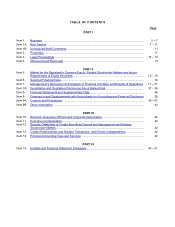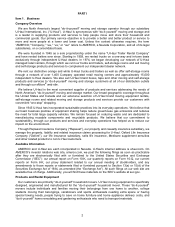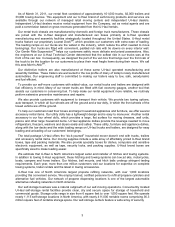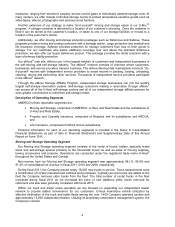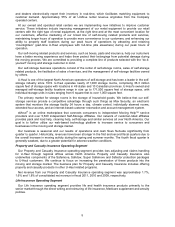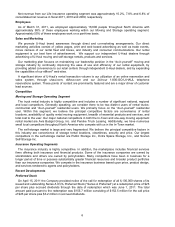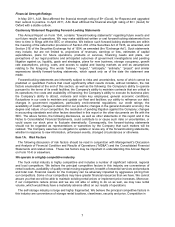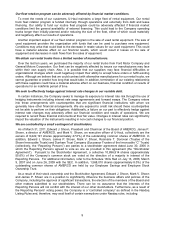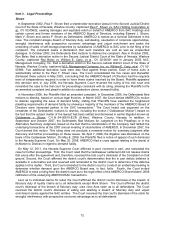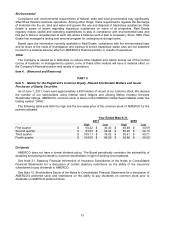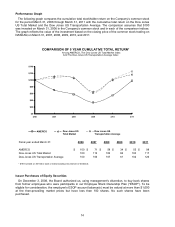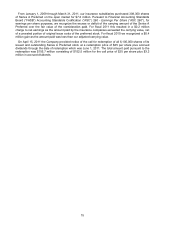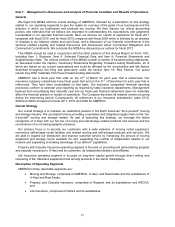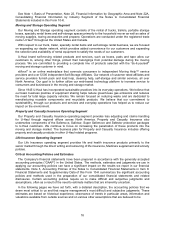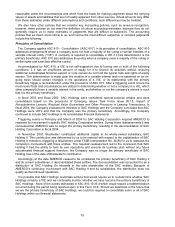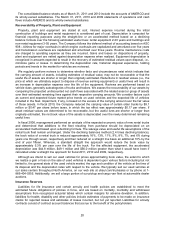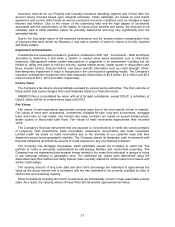U-Haul 2011 Annual Report Download - page 16
Download and view the complete annual report
Please find page 16 of the 2011 U-Haul annual report below. You can navigate through the pages in the report by either clicking on the pages listed below, or by using the keyword search tool below to find specific information within the annual report. 11
In addition, the Federal government may institute some regulation that limits carbon emissions by
setting a maximum amount of carbon entities can emit without penalty. This would likely affect everyone
who uses fossil fuels and would disproportionately affect users in the highway transportation industries.
While there are too many variables at this time to assess the impact of the various proposed federal and
state regulations that could affect carbon emissions, many experts believe these proposed rules could
significantly affect the way companies operate in their industries.
Our ability to attract and retain qualified employees, and changes in laws or other labor issues
could adversely affect our business and our results of operations.
The success of our business is predicated upon our workforce providing excellent customer service.
Our ability to attract and retain this employee base may be inhibited due to prevailing wage rates, benefit
costs and the adoption of new or revised employment and labor laws and regulations. Should this occur
we may be unable to provide service in certain areas or we may experience significantly increased costs
of labor that could adversely affect our results of operations and financial condition.
We are highly dependent upon our automated systems and the Internet for managing our
business.
Our information systems are largely Internet-based, including our point-of-sale reservation system and
telephone systems. While our reliance on this technology lowers our cost of providing service and
expands our abilities to serve, it exposes the Company to various risks including natural and man-made
disasters. We have put into place backup systems and alternative procedures to mitigate this risk.
However, disruptions or breaches in any portion of these systems could adversely affect our results of
operations and financial condition.
A.M. Best financial strength ratings are crucial to our life insurance business.
In April 2011, A.M. Best affirmed the financial strength rating for Oxford, Christian Fidelity Life
Insurance Company, North American Insurance Company and Dallas General Life Insurance Company
(“DGLIC”) of B++ with a stable outlook. Financial strength ratings are important external factors that can
affect the success of Oxford’s business plans. Accordingly, if Oxford’s ratings, relative to its competitors,
are not maintained or do not continue to improve, Oxford may not be able to retain and attract business
as currently planned, which could adversely affect our results of operations and financial condition.
We may incur losses due to our reinsurers’ or counterparties’ failure to perform under existing
contracts or we may be unable to secure sufficient reinsurance or hedging protection in the
future.
We use reinsurance and derivative contracts to mitigate our risk of loss in various circumstances;
primarily at Repwest and for our Moving and Storage operating segment. These agreements do not
release us from our primary obligations and therefore we remain ultimately responsible for these potential
costs. We cannot provide assurance that these reinsurers or counterparties will fulfill their obligations.
Their inability or unwillingness to make payments to us under the terms of the contracts may have a
material adverse effect on our financial condition and results of operation.
At December 31, 2010, Repwest reported $1.0 million of reinsurance recoverables, net of allowances
and $167.3 million of reserves and liabilities ceded to reinsurers. Of this, our largest exposure to a single
reinsurer was $53.7 million.
Item 1B. Unresolved Staff Comments
We have no unresolved staff comments at March 31, 2011.
Item 2. Properties
The Company, through its legal subsidiaries, owns property, plant and equipment that are utilized in the
manufacturing, repair and rental of U-Haul equipment and storage space, as well as providing office
space for the Company. Such facilities exist throughout the United States and Canada. The Company
also manages storage facilities owned by others. The Company operates over 1,400 U-Haul retail centers
of which 479 are managed for other owners, and operates 12 manufacturing and assembly facilities. We
also operate 175 fixed-site repair facilities located throughout the United States and Canada. These
facilities are used primarily for the benefit of our Moving and Storage operating segment.


